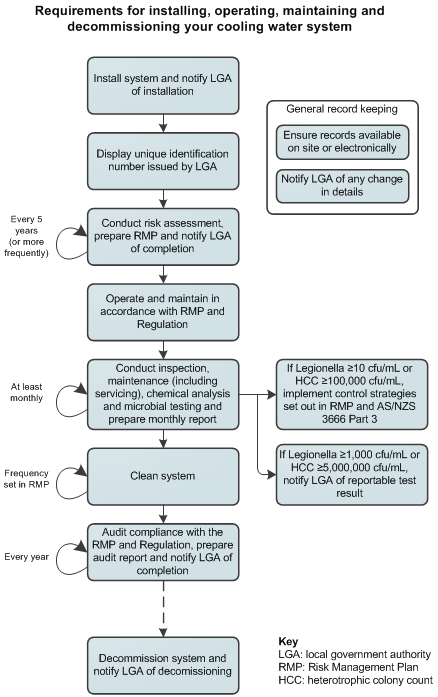
Installing the system
The occupier and the duly qualified person (DQP) must install the system in accordance with AS/NZS 3666.1:2011 Air-handling and water systems of buildings - Microbial control - Design, installation and commissioning. There must be safe and easy access to a cooling water system for cleaning, inspection and maintenance of the system.
The occupier must notify the local government authority of the installation within 1 month by completing the notification of installation or change in particulars form (Approved Form 6).
Displaying unique identification numbers
When notified of a newly installed cooling water system, the local government authority provides occupiers with a unique identification number for each cooling tower on the system.
The occupier must clearly display the unique identification number on each cooling tower within 30 days of receiving the number.
Undertaking risk assessments
The occupier may engage a competent person to undertake a risk assessment and document the findings in a Risk Management Plan (RMP) (Approved Form 1). The risk assessment and RMP must identify and document measures to limit the growth and transmission of Legionella bacteria. The risk assessment must classify the system as low, medium or high risk.
A risk assessment must be completed at least every five years. More frequent risk assessments are required if:
- the system was found to be high risk
- the risk level of the system has changed
- the previous risk assessment is no longer valid
- an authorised officer requires a new risk assessment.
The circumstances and criteria for undertaking a new risk assessment are further outlined in the NSW Guidelines for Legionella Control in Cooling Water Systems.
The competent person must document the risk assessment in the RMP. This form includes a certificate of RMP completion for the competent person to complete. The occupier must provide this certificate to the local government authority within 7 days of the completion of the risk assessment.
Operating and maintaining the system
The occupier and the DQP must operate the system in accordance with AS/NZS 3666.2:2011 Air-handling and water systems of buildings - Microbial control - Operation and maintenance, and maintain the system in accordance with AS/NZS 3666.3:2011 Air-handling and water systems of buildings - Microbial control - Performance-based maintenance of cooling water systems, and the RMP.
When carrying out maintenance, the DQP must minimise contamination of the environment from liquids or aerosol dispersion and prevent public access to the area.
Carrying out monthly maintenance
The DQP must carry out inspection, maintenance (including servicing), chemical analysis, and microbial testing (for Legionella count and heterotrophic colony count) every month, or more frequently if required by the RMP.
The DQP must complete a monthly report (Approved Form 3) each month to document the results of the above, as well as any remedial actions taken or recommended.
The DQP collects cooling water samples which are delivered to a laboratory accredited by the National Association of Testing Authorities (NATA). Samples are tested for Legionella count and heterotrophic colony count.
The DQP must carry out system cleaning at the frequency specified in the RMP.
Responding to microbial test results
The DQP must urgently implement control strategies set out in the RMP and AS/NZS 3666 Part 3 if a test result shows:
- Legionella count ≥10 cfu/mL
- Heterotrophic colony count ≥100,000 cfu/mL.
The occupier must notify a test result to the local government authority as a reportable test result if it shows:
- Legionella count ≥1,000 cfu/mL
- Heterotrophic colony count ≥5,000,000 cfu/mL.
These levels are associated with likely exposure of local populations to Legionella and require urgent follow up in order to prevent an outbreak of Legionnaires’ disease.
The reportable test result must be notified to the local government authority within 24 hours of receiving the result. The notification must be made in writing by completing the notification of reportable test results form (Approved Form 4).
Depending on their contractual arrangements, the occupier, DQP or laboratory may make the notification to the local government authority.
Conducting independent audits
The occupier must engage an independent auditor to audit compliance with the RMP and Regulation every year. Each audit must cover a 12 month audit period, which commences on the first day of the month following the month in which the risk assessment was undertaken.
The independent auditor must document the audit in the audit report (Approved Form 2), within two months after the end of the 12 month audit period. This form includes a certificate of audit completion for the independent auditor to complete. The occupier must provide the certificate to the local government authority within 7 days of the completion of the audit.
The local government authority will review the certificate of audit completion, and may investigate systems that do not comply with the RMP and Regulation.
Record keeping
The occupier must ensure that required records and information are either kept in hard copy on the premises, or kept electronically and made available for inspection within 4 hours of request by an authorised officer.
The occupier must notify the local government authority of a change in particulars (for example, adding a new cooling tower) within 7 days.
Decommissioning the system
The occupier must notify the local government authority of the decommissioning within 7 days by completing the notification of installation or change in particulars form (Approved Form 6).
For more information
